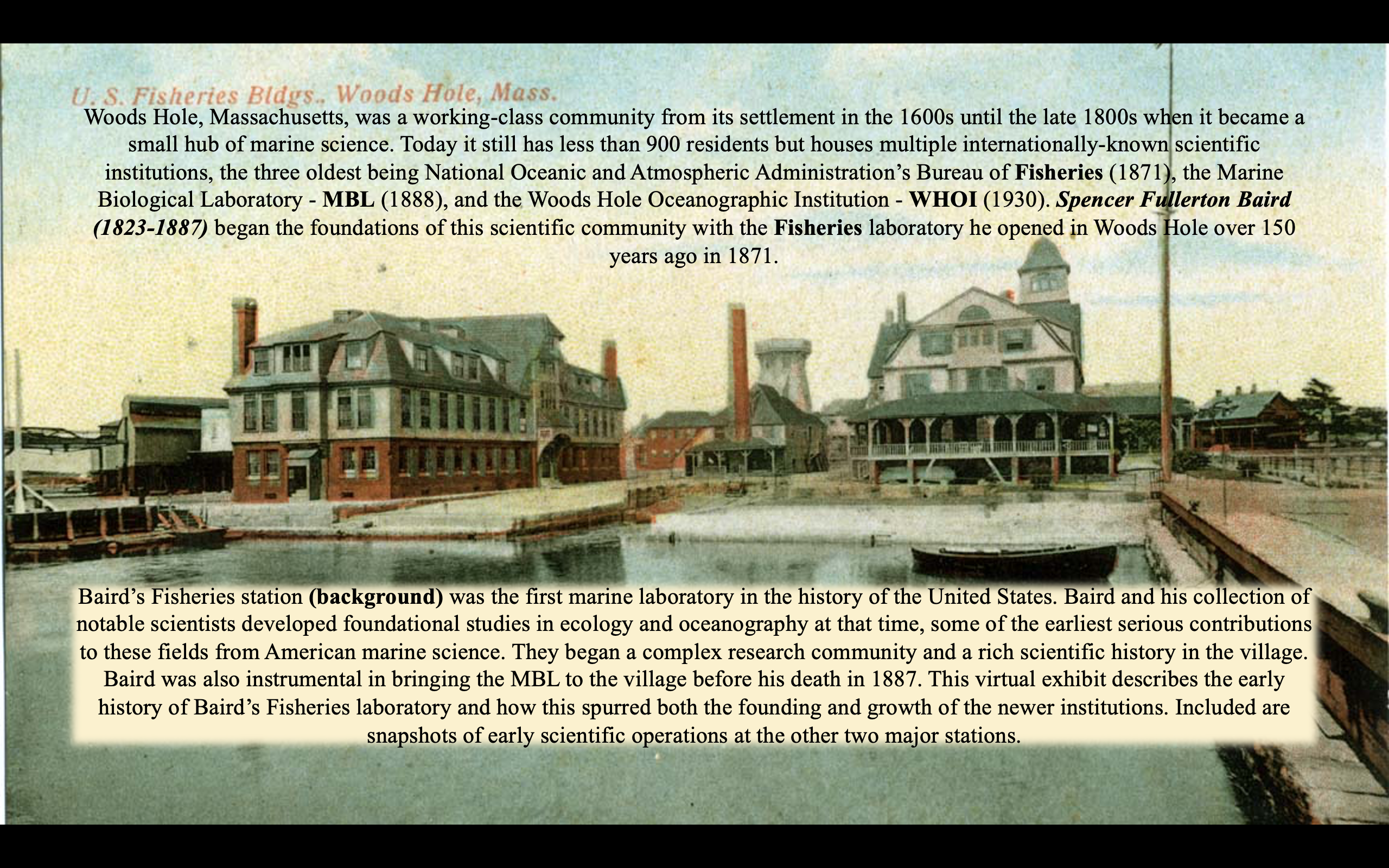150 Years of Woods Hole Science
2

Background image: U.S. Fisheries Commission buildings[sic] and boat basin Credit- Woods Hole Historical Museum
References:
Allard Jr, D.C., 1967. SPENCER FULLERTON BAIRD AND THE UNITED STATES FISH COMMISSION: A STUDY IN THE HISTORY OF AMERICAN SCIENCE. The George Washington University.
p 3: “…Baird quietly used the Fish Commission to launch an ambitious program of abstract research in marine biology. Able scientists were recruited, superb research collections were gathered, and numerous scientific papers were produced. Although this distinguished program had some value for the Commission’s other tasks, it certainly exceeded the intent of Congress, which viewed the Fish Commission as a utilitarian agency…the Commission’s scientific program was the first sustained study of marine biology in the United States. The research ship Albatross, which served science until 1921, and the famed Marine Biological Laboratory at Woods Hole, Massachusetts, which flowed logically from foundations laid by Baird, symbolized the Fish Commission’s long-range importance. The history of the U. S. Fish Commission reveals Spencer Baird’s outstanding ability as a scientific organizer and his major impact on the development of American science.”
Lillie, F.R. and Conklin, E.G., 1944. Woods Hole Marine Biological Laboratory.
[contrary to Lillie’s statement]:
p. 15:
“The first American seaside laboratory was founded in 1873 by Louis Agassiz on the remote island of Penikese in Buzzards Bay..”
[, the Fisheries laboratory was the first seaside laboratory in America; the later parts of this presentation will point out why this was not true.]
[This was likely due to ideas of the time of Whitman the efforts of Fisheries and their contributions to knowledge of ecology and oceanography were not considered scientific, especially when the organization that carried out such studies was founded as a “strictly economic” organization. It is also clear that his definition of a biological station was more idealistic, where the ends justify the means.]:
MBL Minutes of the Trustees, 1888
p. 29 (Whitman’s opening address):
”…it must not be forgotten that the raison d’etre of the Fish Commission is strictly economic. Its organization and its support must continue to be directed and gauged, as they always have been, by the practical benefits expected from fish culture. Its scientific field is limited in two ways: first, by the nature of its work, and second, by its aim to reach economical results. These are simply matters of fact, disputed by no one, and referred to here merely to clear the ground. No one has anything to say in derogation of such work; on the contrary, all, so far as I know, approve both of its character and its aims. The point to be emphasized here is this: however important these economic purposes, and however liberally and successfully pursued, they cannot by any possibility be stretched to the dimensions of a Marine Biological Station. There is no antagonism between science and’ economy, but the field is comparatively narrow in which both can be successfully cultivated at the same time. Biological investigation must neither be limited in scope, nor handicapped by utilitarian considerations. Most of the problems now occupying the attention of biologists must be dealt with as questions entirely outside the sphere of so-called "practical" claims. We approach them only from the standpoint of pure science, and never ask haw much their solution will contribute, either directly or indirectly, to the comforts and necessities of life. A biological station should be a purely scientific affair from beginning to end. It should have no other aim than to advance science, and its whole organization should be directed to this one great end. We are urged by every consideration of the present, and every regard for the future of biological science in America, to keep this object steadily in view, and to allow nothing to block the way to its attainment.
[However, this presentation points out that despite its being founded as an agency with these interests, Fisheries in its early days was a hub of basic marine science, ensured Agassiz’s Penikese School was not a failure, and led to the founding of the other two major institutions in later years. It was definitely an institution which conducted basic research methodologies, despite its mission and purpose according to Congress.]
IMAGE REFERENCES FOR TITLE SLIDE:
Background image: Woods Hole street map, 1887. Credit: NOAA Fisheries. From NOAA archives gallery at https://apps-nefsc.fisheries.noaa.gov/rcb/photogallery/assorted.html
Clickable Figure: Medusa of Aeginura Grimaldi (bottom view) by Ernst Haeckel. Public Domain image from https://en.wikipedia.org/wiki/Ernst_Haeckel#/media/File:Aeginura_grimaldii_by_Haeckel.png